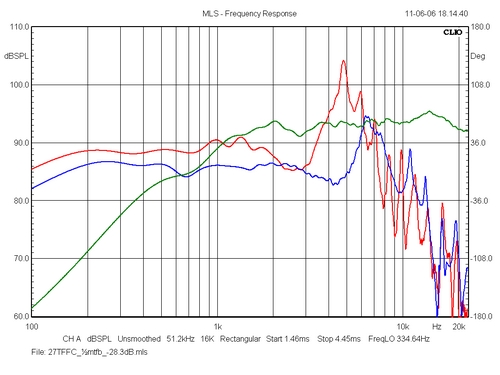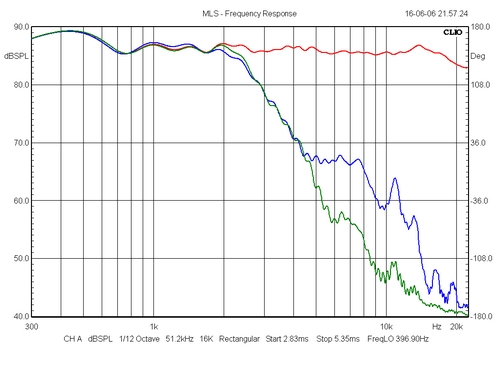The are a few points that haven't been adequately addressed in this discussion. First, most woofers and mid-woofers, irrespective of cone material, have prominent break-up modes that have to be dealt with. Just take a look at the ceramic woofer used by Revel in their PerformaBe M126Be:
https://www.madisoundspeakerstore.c...coustics-sb17cac35-8-6-ceramic-woofer-8-ohms/
or a ScanSpeak fiberglass woofer:
https://www.madisoundspeakerstore.c...eak-discovery-18w/4434g-00-7-midwoofer-4-ohm/ or see the attached raw measurement of the paper cone woofer used in my Affordable Accuracy monitor. Although the peaks on the Seas Excel woofers certainly look a little frightening because of their height, they are very high Q (narrow), and actually easier to deal with than the more chaotic and wider band breakup modes of many other woofers. Looking at the W18 in particular, since I believe this is the woofer used on the MG-1, It takes only 3 components to virtually eliminate the peak and suppress the second peak by by
30 dB. Using 4 additional inexpensive components, the second peak can be reduced to more than 40 dB down (although I don't think that's necessary). So it simply isn't true that heroic measures are needed to tame the Excel drivers. I wish all of the drivers I work with were as easy. It took 6 components to get the AA woofer peak down 30 dB.
There is one criticism leveled at the W18 that at least has a theoretical basis. Unless the woofer is crossed below 1600 Hz (and that would be difficult in a 2-way), any third order distortion product generated at that frequency will excite the cone resonance no matter how steep the low pass slope is. That's because the 3rd harmonic at 1600 Hz is 3200 + 1600 = 4800 Hz, which is exactly the center of the W18's breakup peak. The crossover won't suppress the 1600 Hz signal, and so that resonant peak will intensify whatever 3rd order distortion is present at 4800 Hz. Fortunately, the W18's upper midrange distortion is very low, due to the well engineered motor and perhaps the stiff cone, and you can see from the Klippel distortion test that the MG-1 in fact has admirably low distortion across the treble band. The bottom line is that the Excel drivers are excellent and easy to implement. I've literally lost track of how many speakers I've designed using them.


